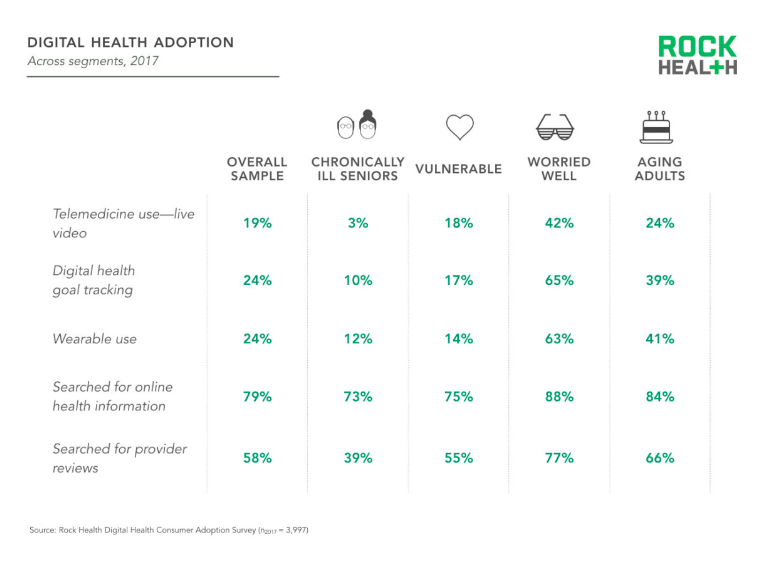9 in 10 Americans dig digital health tools
Nearly 90 percent of American consumers used digital health tools such as telemedicine, wearables and online health information in 2017, according to a recent survey. Usage is trending up—from the 80 percent who used at least one digital health tool in 2015.
While overall digital use is rising, consumers tend to favor some technologies over others, the survey by Rock Health found. Online health information and providers reviews were by far the most utilized digital health tools—79 percent and 58 percent of respondents use these– compared to wearables, video telemedicine and mobile tracking—24 percent, 19 percent and 24 percent, respectively.
The survey reveals that more consumers are willing to use technology alongside their healthcare usage at a time when major companies are ramping up their digital health capabilities. CVS Health recently launched a new mobile telehealth service, while Apple has continually made plays to accelerate digital health technology, from wearables to apps.
“The good news for digital health innovators is consumers generally like using their products," Megan Zweig, director of research at Rock Health, told HealthExec. "People are largely satisfied with their telemedicine visits, and even report that wearables and other health tracking apps are helping them achieve their health goals."
Those who did use some digital health tools said their experiences were what they hoped for and even helped improve their health goals, the survey said. Among people who used live video telemedicine, 69 percent of respondents who paid out of pocket for the service saying they were “extremely satisfied” compared to 30 percent who did not pay out of pocket. An in-person visit prior to a telemedicine visit with the same provider also led to higher satisfaction, underscoring the ability of healthcare organizations to build long-term relationships with patients and create great experiences via technology.
"Relationships really do matter in healthcare, and this is evident in how consumers interact with digital tools," Zweig said.
Wearables also helped with health goals, including tracking weight, physical activity, sleep and medication adherence. More than half of respondents use wearables to track physical activities, while 40 percent use the tech to lose weight. Roughly a quarter of users track sleep, and 18 percent use wearables to manage stress.
Consumers were also more likely to trust providers over tech companies when it comes to sharing digital healthcare data.
"Consumers are much more likely to trust in provider data security and share their healthcare data with providers—especially compared to tech companies," Zweig said. "This means providers have substantial sway in terms of digital tool adoption—a prescription or recommendation from a care team member is going to carry a lot of weight with a patient. Meanwhile, digital health companies need to think deeply about how they build relationship capital with their users, and figure out where a human touch point will go a long way toward cultivating user trust and engagement.”
The spread of who uses wearables varies and is inconsistent among high-need population with health challenges, the survey found. People with a challenge such as high blood pressure are more likely to track their health goals, but just 11 percent said they do so with a digital app. Among obese respondents, just 20 percent tracked their weight in a digital app, compared to 29 percent who tracked their diet and 56 percent who tracked their physical activity.
Chronically ill older Americans were the least likely to use digital health tools, but they also could benefit the most. Young, high-income adults are much more likely to adopt digital health tools, even though older adults are likely to frequent doctors’ offices more often and manage at least one prescription.
"The issue is widespread adoption and use," Zweig said. "For the most part, these tools—particularly live video telemedicine—aren’t consistently reaching underserved and chronically ill populations. Part of the issue may be cost, part of it may be awareness. But we’re particularly excited by those who are both building products explicitly for those who need it the most and figuring out the right reimbursement pathway to reduce access barriers.”


